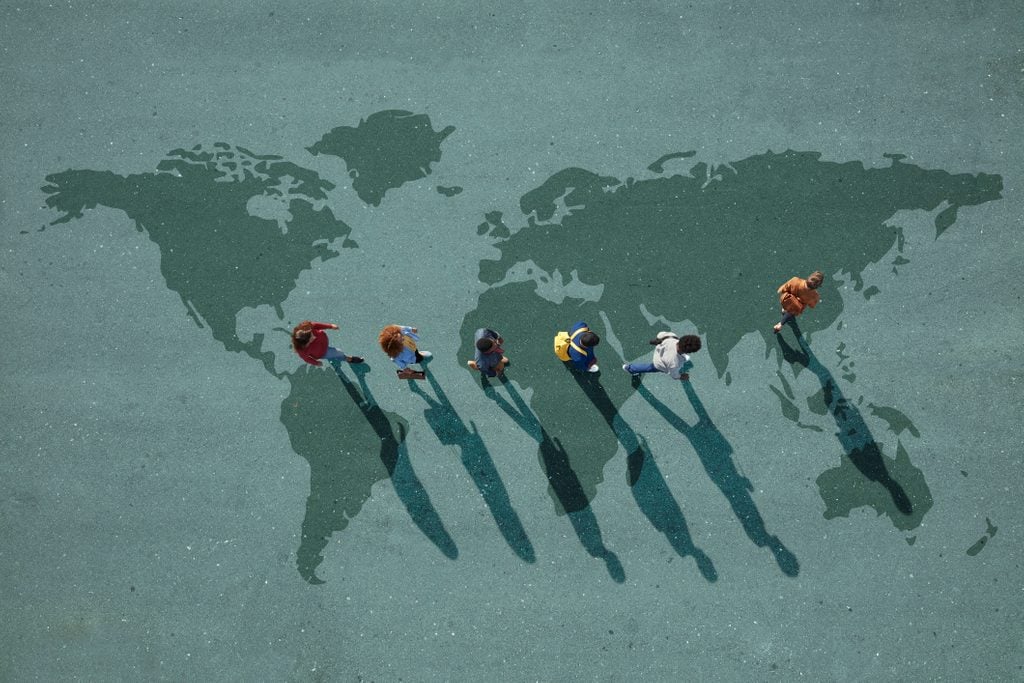Where Did the Concept of Race Come from, Anyway?
Updated: Nov. 03, 2022

What began as a concept of classification evolved into an agent of war and a symbol of supremacy and oppression that continues to haunt humankind to this day.
We tend to think of race as a scientific construct that has existed as long as people have, but, in fact, it’s a relatively recent concept. Today, the meaning of the word pretty much depends on who is using it. To some, there is a single race, the human one. For others, its as simple as Black and White—a distinction that forms the basis of the anti-Black sentiment we now think of as racism. When talking about diversity and discrimination, we tend to use the term “race” more loosely, applying it not only to indicate different skin colors but different religions and ethnicities as well. It’s hard to imagine that everyone will ever agree on what constitutes “race,” but the concept’s effect on modern society has been immeasurable. Filmmakers frequently return to the topic of race; here are 12 documentaries about it.
The origin of race
It’s probably impossible to pinpoint the origins of race to one time and place, but racism as we know it existed long before White settlers of European-descent enslaved Black Africans. In the later part of the 14th century, there was an anti-Jewish contingent in Spain that demanded conversion or death; the period became known as the Spanish Inquisition. On June 5, 1449, Pedro Sarmiento issued the Sentencia-Estatuto, which barred Jewish converts to Christianity who couldn’t prove four generations of affiliation from holding private or public office and receiving church land grants. According to anti-Semitism expert Leon Poliakov, author of The History of Anti-Semitism, it was “the first example in history of legalized racism.” Anti-Semitism is an all too common attitude, but this town did not accept it.
Race and the enlightenment
During the 18th century, European Enlightenment-era scholars and scientists including Swedish botanist Carolus Linnaeus and German physiologist Johann Friedrich Blumenbach further solidified the basis for race and, by extension, racism. Influenced by the classification systems earlier botanists and biologists had developed for plants, Linnaeus created genus and species terms for all animals, separating the human species, Homo sapiens, into four major subdivisions: H. americanus, H. africanus. H. europaeus, and H. asiaticus. His revolutionary and influential work may have helped form the basis for what we now consider to be race, but as he suggested in 1737’s Critica botanica, Linnaeus wasn’t thinking in those terms: “[God] created one man only, dictates Scripture to us, yet if the slightest trait [difference] was enough, there would easily stick out thousands of different species of man: they display, namely, white, red, black and grey hair; white, rosy, tawny and black faces; straight, stubby, crooked, flattened, and aquiline noses; among them we find giants and pygmies, fat and skinny people, erect, humpy, brittle, and lame people etc. etc. But who with a sane mind would be so frivolous as to call these distinct species?” Find out why one person says that you should stop saying “I don’t see color.”
Enter White supremacy
At the end of the 1700s, Blumenbach came up with five human categories: American, Malay, Ethiopian, Mongolian, and Caucasian. Tellingly, Blumenbach chose the term “Caucasian” to represent Europeans because he considered a skull he’d found in the Caucasus Mountains of Russia to be his most beautiful discovery. The classification systems of both Linneaus and Blumenbach included cultural observations as well as subjective biases that may have not only formed the basis of the race classifications predominantly used today—Caucasian, Mongoloid, Negroid, and Australoid—but also influenced Western attitudes toward them. “Blumenbach’s ideas were a reflection of the unconscious bias and White racial pride of his era, and when he created the first racial schema of five races, he placed Caucasians at the apex,” Joel Dinerstein, an English professor at Tulane University, wrote in the Los Angeles Times in 2019. “In the years following Blumenbach’s suppositions, they came to be widely cited as proof of white racial superiority, especially in the young republic of the United States. Over the next century, scholars gave scientific cover to the idea that racial groups had distinctive genetic character traits. The new American nation absorbed Blumenbach’s racial theories, and they remain ingrained in our legal history, racial ideology, and national identity.” This is why you should stop asking people of color where they’re from.
The arrival of race in the English-speaking world
One of the earliest known uses of “race” in the English language was in the late 16th century when it had a different meaning than the one we apply to it today. Back then, it was a term of categorization used to rank human beings by, in a sense, class rather than appearance. In the days of Shakespeare, people might refer to a “race of saints” or a “race of bishops.” Generally and naturally, they were referring solely to people of the race that would later be known as Caucasian. “According to the Oxford English Dictionary, the word ‘race’ was first used by the Scottish poet William Dunbar and here the word means ‘group,'” Marialuisa Sapienza wrote in Yale National Initiative’s “Race and Gender in Shakespeare and the Art of Rhetoric.” “Shakespeare uses it referring to lineage or national grouping as it is expressed in Sir John Wynne’s History of Gwydir Family in reference to the British race. He also uses it in defining a group of women or class identities, but he never uses it in relation to Blackness.” Speaking of Shakespeare, you may not believe how many everyday expressions originated with him.
Racism leaves its legacy
By the 18th century, as colonization in the New World introduced Europeans to people from different parts of the planet that had markedly different cultures and appearances, “race” began to take on a different meaning. Settlers on the American continents used it to separate themselves from Native Americans (Amerindians) and the Black people who had been imported from Africa as slaves. Thomas Jefferson, the future third president of the United States, expounded on the evolving concept of race in his 1785 book Notes on the State of Virginia: “Deep-rooted prejudices entertained by the Whites; ten thousand recollections, by the Blacks, of the injuries they have sustained; new provocations; the real distinctions which nature has made…will divide us into parties, and produce convulsions which will probably never end but in the extermination of the one or the other race. To these objections, which are political, may be added others, which are physical and moral. The first difference which strikes us is that of colour.” Jefferson also wrote the Declaration of Independence. How well do you know the iconic document?
The “Black” Irish
The English didn’t reserve their system of segregation only for people originating on other continents who looked significantly different. As early as the 17th century, they were lumping the Irish into the “other” category and regarding them as savages. Indeed, they were considered the Black people of Europe. Although the Irish resisted England’s attempts to overtake and tame them, these negative attitudes were something of a precursor to how they would later view Native Americans and especially Africans. “Irish and Africans Americans had lots in common and lots of contact during this period [the mid-19th century]; they lived side by side and shared workspaces,” Art McDonald, the Social Advocacy Directory at Allegheny Unitarian Universalist Church, wrote in “How the Irish Became White.” “In the early years of immigration, poor Irish and Black people were thrown together, very much part of the same class competing for the same jobs. In the census of 1850, the term ‘mulatto’ appears for the first time due primarily to inter-marriage between Irish and African Americans. The Irish were often referred to as ‘Negroes turned inside out’ and Negroes as ‘smoked Irish.'”
Race and slavery
New Word Settlers were battling Indians for their land and enslaving Africans at the same time, but both groups faced wildly different fates in America. Africans had more immunity to the diseases Europeans brought from the old continent to the new one, unlike Native Americans, many of whom succumbed to them. In other words, there weren’t enough Native Americans to assume the manual labor required to keep the colonies’ economies afloat. Even if they had survived in larger numbers, Native Americans knew the lay of the land, so they stood a much better chance of escaping captivity than Africans, who were trapped physically and geographically. Although slavery wasn’t a new concept globally, it was a unique institution as it existed in America. “The thing that makes American slavery so distinctive is it is based on race,” George Washington University professor James O. Horton told PBS in 2003. “America’s slavery is justified not, for example, as West African slavery is justified—where people were captured in battle and then held in a kind of captivity.” How much do you actually know about the end of slavery? Find out about Juneteenth and why we celebrate it.
Race: The great divider
Although the demands of slavery required an enormous amount of strength and stamina, White Americans regarded Africans as being intellectually inferior and therefore better suited to lives of enslavement. As they saw it, God had created a hierarchy of men in which White people were at the top and Black people were at the bottom. The successful Haitian rebellion of 1791 created a sort of contradictory view of Black people as something to look down on and something to fear. As the United States entered the Jacksonian Age of 7th U.S. President Andrew Jackson (1829 to 1837), what were seen as extreme differences between White and Black people had taken on the level of separation that people applied to different species. “By the time we get to Jackson, who speaks out in a kind of populist way—speaking for the little guy, speaking out against privilege—his little guy, his citizen, is increasingly a White male citizen,” James O. Horton told PBS. “By the time of Jacksonian America, race has become one of the most important dividers that exist in America.” Learn why desegregation didn’t put an end to racism in America.
Race and immigration
Even after the Civil War led to the emancipation of the slaves, segregation and Jim Crow laws kept the so-called races separate. The influx of people from other parts of the world into the United States made classification more important to the ruling class. “The history of U.S. immigration and nationality law demonstrates how race became a factor in determining who could come to America and who could not,” Marian L. Smith wrote in Prologue Magazine in 2002. “Studies of Chinese exclusion laws or the old immigration ‘quota system’ trace a tradition of racist immigration policy.” People from other European countries as well as Jewish settlers spoke different languages and were subject to certain prejudices, but unlike the Chinese, who started immigrating to the United States in the 1850s seeking fortunes in California gold, they could physically assimilate into Anglo-Saxon culture. They were, in essence, White. Find out which term you should be using today: Black or African American.
Race and colonialism
During the 19th and 20th centuries, European colonization of Asian and African countries aided and abetted the idea of racial superiority. “What is sometimes overlooked is that the racial ideas of the pro-slavery lobby were also aimed at Africans in their home continent,” David Olusoga wrote in the Guardian in 2015. “The impact of Atlantic slavery on Africa can be measured not just in terms of underdevelopment and depopulation, but also in the way in which the continent came to be imagined in Europe in the post-slavery era, during which all but two of Africa’s nations were colonized by the competing European powers.” The invade-and-conquer ethic extended to Australia and New Zealand where White people of European descent launched attempts to exterminate Tasmanians, Maori, and indigenous Australians. In South Africa, apartheid kept the spirit of racism alive and well, as the failure of Reconstruction did in the United States. By the time the Civil Rights Act of 1964 effectively ended Jim Crow and segregation in the United States, a nearly half-millennium of racist ideology had indelibly shaped the American and European psyches. In spite of that, the clenched fist became a symbol of Black power.
Race and the Holocaust
The idea of an Aryan race that is superior to all others directly led to the Holocaust during World War II. Roughly two out of every three Jews living in Europe at the time were killed, as the death toll passed 6 million. Nazi Party leader Adolph Hitler targeted Jews as Aryan enemy number one, using perhaps an even narrower definition of White supremacy than the one being espoused simultaneously by the Ku Klux Klan in the United States. According to editorial material published by the United States Holocaust Memorial Museum in Washington D.C., “Hitler’s program of war and genocide stemmed from what he saw as an equation: ‘Aryan’ Germans would have to expand and dominate, a process requiring the elimination of all racial threats—especially the Jews—or else they would face extinction themselves.”
An end to race?
Has the idea or race run its course? In the weeks since the May 25 murder of George Floyd by a White policeman sparked a proliferation of Black Lives Matter protests around the world, the idea of race has been scrutinized more closely than it has since the Black civil rights movement of the 1950s and 1960s. Is it time to let go of the concept that has created such a deep schism in American society? Science and academia haven’t been on its side for years and perhaps never really were. “There is a long history of justifying the subordination of different groups and social groupings based on myths about their biologic or genetic predispositions,” Dorothy Roberts, a legal scholar, sociologist, and a professor at the University of Pennsylvania’s Africana Studies department, told NPR in 2013. “It’s not only that there’s scientific evidence that humans aren’t divided into discrete biological categories we’d call races. But there’s also evidence of the harm these biological meanings of race have caused for centuries.” Sadly, racism is embedded in the English language, in places you might not expect to find it.
For more on this important issue, see our guide to the Fight Against Racism.
Sources:
- Poliakov, L. The History of Anti-Semitism
- Science, Technology, and Human Values: “Race and History: Comments from an Epistemological Point of View”
- Los Angeles Times: “Opinion: The pernicious myth of a Caucasian race”
- Yale National Initiative: “Race and Gender in Shakespeare and the Art of Rhetoric.”
- Jefferson, T. Notes on the State of Virginia
- Pittsburgh University: “How the Irish Became White”
- PBS: “Race—The Power of Illusion”
- Prologue Magazine: “Race Nationality, and Reality
- The Guardian: The roots of European racism lie in the slave trade, colonialism – and Edward Long
- NPR: Is It Time To Stop Using Race In Medical Research?



